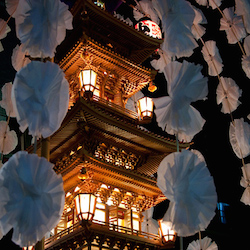Sep 21, 2016
Oeshiki Festival of Light at Ikegami Honmonji Temple in Tokyo
 In the autumn of 1282 Nichiren, the founder of the branch of Buddhism that now bears his name, plagued by ill health, was persuaded to leave his home of Minobu and seek out hot springs for their perceived medicinal benefits. In the company of a handful of his most trusted disciples, after ten days of travel he came to the home of one of his believers, a daimyo named Ikegami Munenaka, fifteen kilometres from modern day Tokyo. Though he received the best of care, three weeks later on October 13 Nichiren passed away. In Ikegami Honmonji Temple’s courtyard a sakura tree, some six months out of season, blossomed in mourning at the passing of the great man.
In the autumn of 1282 Nichiren, the founder of the branch of Buddhism that now bears his name, plagued by ill health, was persuaded to leave his home of Minobu and seek out hot springs for their perceived medicinal benefits. In the company of a handful of his most trusted disciples, after ten days of travel he came to the home of one of his believers, a daimyo named Ikegami Munenaka, fifteen kilometres from modern day Tokyo. Though he received the best of care, three weeks later on October 13 Nichiren passed away. In Ikegami Honmonji Temple’s courtyard a sakura tree, some six months out of season, blossomed in mourning at the passing of the great man.
Today the various denominations of Nichiren based Buddhism have more than 5,000 temples across Japan and are followed by millions of people all over the world. These believers will come together from the 11th to 13th of October to celebrate the Oeshiki festival, marking the death of their spiritual leader. The most prestigious of these celebrations is held at Ikegami Honmonji Temple, the former home of Ikegami Munenaka; the scene of Nichiren’s final breath.
Here 300,000 followers and spectators will gather to watch an effervescent ‘mando’ parade, quite literally 10,000 lights. From 6:30 pm, at two ends of the village, flickering floats will be carried along a two kilometer stretch of Ikegami-dori, heading towards the Ikegami Honmonji Temple.
These floats, carried to the temple by 3,000 happi coat-wearing devotees from all over the country, are constructed to give the appearance of a five story pagoda, iridescently lit from the inside. These are adorned with artificial cherry blossom branches, cascading from the top in an umbrella pattern, reflecting the pagoda light, giving it the form of an ethereal sakura tree, a representation of the blossom that reflected the final celestial light of Nichiren as he left the mortal world.
The divergent participants’ paths meet at Shin Sando near the entrance of the temple where they wait to enter. Here, in the lull of movement, members of those designated from their local temple to carry matoi, Edo period fireman poles decorated with streamered figures, dance and spin their burdens, sending the streamers spinning out to the delight of the crowd.
If you are thinking that this all sounds a little convivial to commemorate the death of an esteemed religious figure, that’s probably because it is not exactly the festival’s intention. Nichiren’s followers believe that he passed, not into mere death, or even into the next reincarnated life, but instead surpassed the suffering and anguish of being restricted to this world, and into nirvana. As such, this is considered not a mourning of death, but a celebration of birth, and the carnival atmosphere reflects this.
As well as the bright lights and thronging masses, you will also find the usual array of food stalls lining the streets, and the party mood is whipped up by each group as they carry their float up the 96 steps into the temple. Once there, centre stage, they dance and drum for the thronging crowd, before entering the shrine for a blessing ceremony, a ritual repeated by the many other groups for a full five hours, until the culmination of the festival.
Whether or not you follow the Nichiren denomination of Buddhism, or any other religion for that matter, the Oeshiki festival is is well worth a visit. The bright lights, music and festival food make it an enchanting weekend of celebration.
Oeshiki Festival of Light
Ikegami Honmonji Temple
146-8576 Tokyo, Ota Ku, Ikegami, 1-1-1 ( map )
http://honmonji.jp/00index/index2.html
Dates: 11th Oct–13th Oct, annually
Start/End Time: 18:00 – 23:00
Entry: Free
Closest station(s): Ikegami Station on the (Tokyu Ikegami Line


About the author